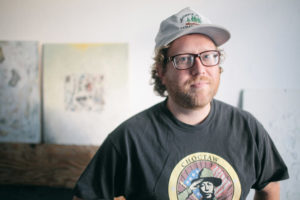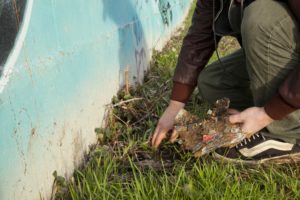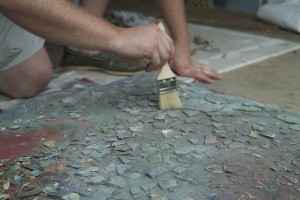Interview with Josh Sands
Josh Sands was ECA’s resident artist for Public Process 4, and was interviewed by artist, writer and ECA volunteer Rosie Lockie. He discusses his Public Process 4 experience, his work and ideas from his final show.
Can you describe your process for the pieces in “Street Artchaeology”?
The project started when I found several large deposits of paint layers underground. The paint fascinated me and so I carefully dug it out and brought it back to my studio. After experimenting with the material for awhile I realized that it was durable paint, and would hold up to a lot of punishment. This prompted me to find a suitable working method for using the found paint chips. First I found large wood surfaces that I primed like regular paintings. Then I used several gallons of recycled latex paint to make a thick surface to essentially glue the paint chips into, by sinking them into the wet latex surface. After it dried I painted over them again, making the paintings monochromatic: white, gray, or black. After all of the paint dried I sanded down the entire surface in order to reveal the paint layers hidden underneath. Finally I put finishing touches on them and let them become paintings.

How did being ECA’s Public Process 4 resident change the way you normally work?
I normally work at home in the barn, or in my quiet glass studio in Eugene. Considering that both of those studios are out in the country, and relatively isolated, it was nice to absorb a lot of the sites and sounds of city life. Whether I controlled it or not, I’m sure that the effects of urban living crept its way into the work, and considering that the paint and my referencing graffiti and street artists, completely fits the project, it seems to be intertwined.
Tell us about the two separate parts to the show and how they are connected.
As I worked more with the found paint chips, I began to see my process similar to that of an archaeologist focusing his study on the physical remains of a culture. Somewhere along the line I had the idea to create a second part of this project that reflected more of a cultural anthropologists working method, focusing more on the current cultural practices, rituals, and languages, instead of fossilized remains. To achieve this I installed large, weathered, plywood boards onto the fence next to the gallery on the street. My goal was to get the local graffiti writers to interact with the pieces, showing us parts of their culture, and teaching the public about it by displaying some of their work. I see both parts of the project being linked together in an overall effort to display a more complete visual understanding of the graffiti culture.
When did your interest/training in archaeological methods start to inform your work as an artist?
Realistically my interest in anthropology has been in my art all along, I just didn’t notice. I went to school for art but I also got another bachelors degree in anthropology. I was always very interested in different cultures but I guess I never truly resolved the underlying reasons why I decided to study those different cultures so heavily. After much thought on the subject I realized that my interest in anthropology was in collecting and conservation, attempting to hold on to history, materials, ephemera, time, etc. Later on I noticed that same vein of collecting and conserving running deep through my work ever since college.
I noticed a good number of the pieces in Street Artchaeology are set up in the same way compositionally: the found paint chips ring an empty void or abstract space. Is there symbolic significance or value to this choice? How do you deal with the space in the painting not being used by the found chips?
I decided early on in the painting process that I was going to limit most of my compositions to simple shapes, like squares, outlines of squares and rectangles. I guess this choice has to do with the straight lines and shapes of architecture, my way of reflecting the street. The remaining inside space or void was dealt with in the finishing stages, where I allowed intuition and my standard painting practice to take over, in order to give the paintings a life of their own by adding and mixing color, then sanding and scraping it away in order to create something beautiful that would stand alone as a work of art.

Do you feel like your work is related to the recent movement of street art and graffiti art into white box style galleries?
Honestly I see myself as any good anthropologist in this situation would: as a total outsider to the culture. Despite learning more about the graffiti/street art culture through my work and research, I don’t feel any more assimilated to that culture. Mostly I feel that by appropriating their materials into my own work I’ve eliminated much of the mystique and aura surrounding the mythic nature of the graffiti painter into something more sterile and institutional, probably more boring, and more related to the white cube. So really I don’t see them as being related stylistically.
What makes a sociological or archaeological perspective more appropriate or interesting compared to looking at street art as contemporary/art historical study?
I don’t think that either perspective is more appropriate for the white box, or more interesting, I just see all of these stylistic choices in terms of how you want to make your art and present them as being a matter of choice. My feelings are that if ten other artists would’ve attempted to produce their own take on this same subject, then ten different perspectives would emerge, some more or less related directly to graffiti. Graffiti is contemporary art, and what I do is contemporary art, they can all fit together in a gallery setting.

I could describe your practice in relation to graffiti art in multiple ways: transformer, translator, preservationist, collaborator etc. How do you see you role in relation to street or graffiti artists?
My initial instinct is to identify with the role of preservationist in this scenario, considering my interest in conservation. Yet it’s very intriguing to consider the other roles you listed and how they relate to my work. I guess I identify least with the role of translator, because I’ve yet to decode a lot of the meanings and motivations that drive the graffiti artist to work, and the language they use to tell their story. I also see problems with identifying as transformer, because much of what I was doing with the found paint was attempting to uncover the layers that were already there in order to exhibit my findings, not to transform the paint, obscure the culture, or reinvent or abstract it in any way. I do however partially identify with my role as artist collaborator in this project, since my aim was to create pieces that intersect at the crux of my interest in anthropology and different cultures, and making my own paintings.
What do you have planned next?
I’ve been collecting materials for a few years now. Using household items, found objects, dirt, nature, etc. I’m putting together large installations continuing with the theme of layers and geologic time. Bigger and better artworks, that’s all I want from here.
Keep up with Josh on his website.